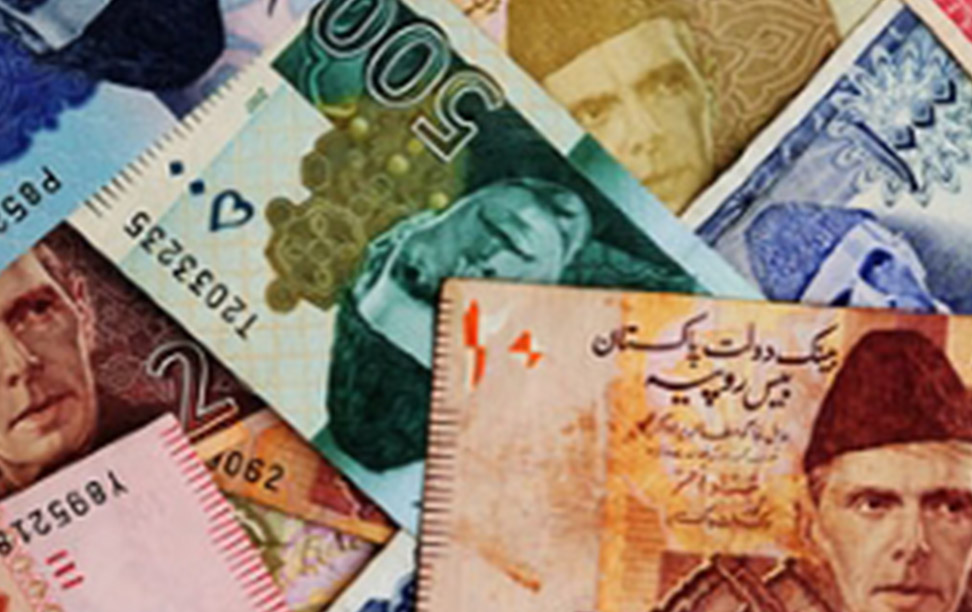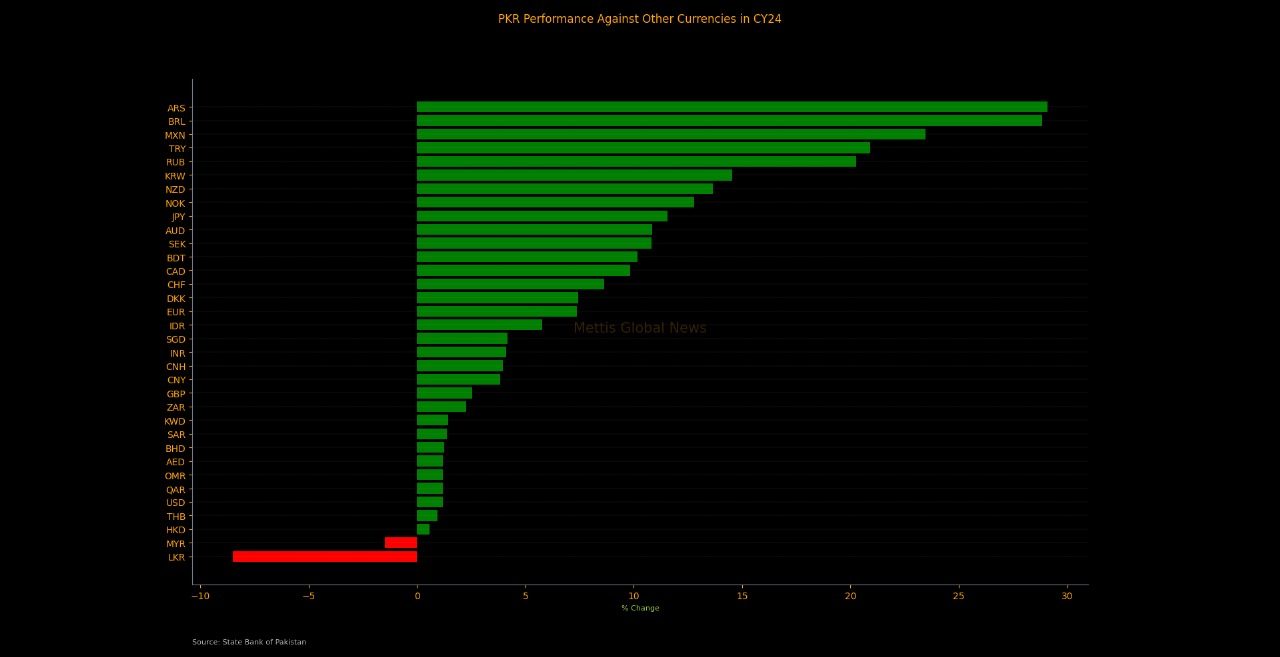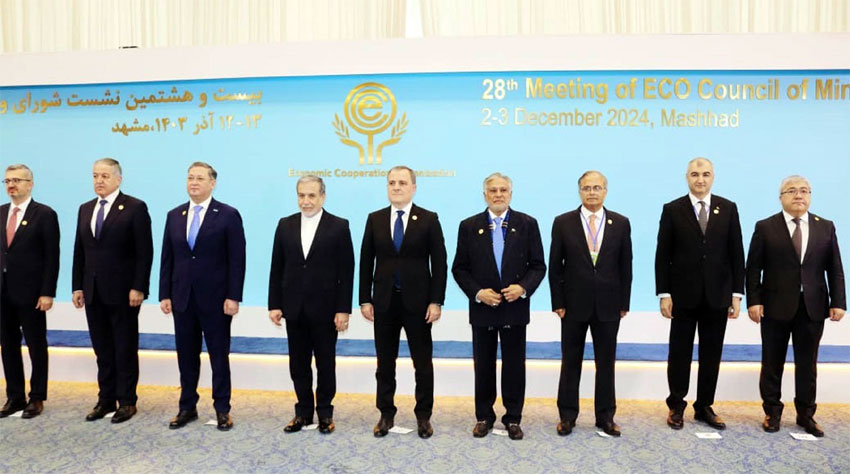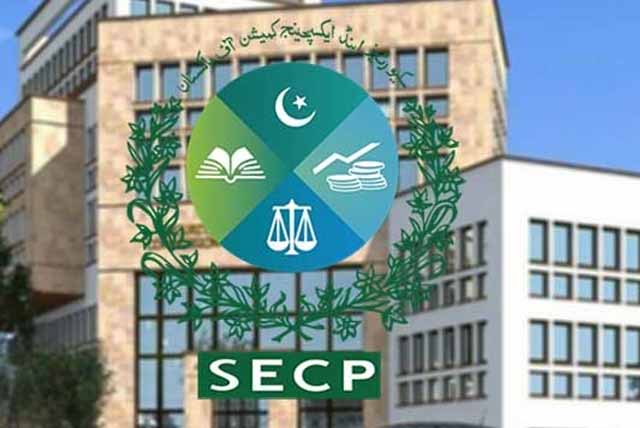PKR in 2024: The Climb to Stability

By Nilam Bano | January 03, 2025 at 12:56 AM GMT+05:00
January 03, 2025 (MLN): Turning the tide in 2024, the Pakistani Rupee (PKR) ended 2024 with a minor yet significant gain of 1.186% or PKR 3.34 against the mighty US dollar for the first time in seven years. No doubt it was a remarkable achievement for a currency once labelled the worst performer which has now been known as the most stabilized currency in a region for a year.
Right before a year, in 2023, the local unit bore the brunt of economic and political mayhem which made it lose an alarming 76.34% of its value—from 159.88 in 2020 to 281.86 in 2023.
Reflecting a positive trend in the exchange rates across the board, the Pakistani Rupee strengthened against all the major currencies in 2024.
The local unit also strengthened significantly against the Euro by 7.14%, with the rate falling from 311.94 to 289.67.
Similarly, the PKR appreciated by 2.86% against the British Pound, from 359.58 to 349.28.
The most notable change occurred against the Japanese Yen, where the PKR strengthened by 10.67%, decreasing from 1.99 in 2023 to 1.78 in 2024.
Against the Saudi Riyal and UAE Dirham, the PKR showed smaller but positive gains of 1.36% and 1.21%, respectively, with the exchange rates moving from 75.13 to 74.10 and from 76.76 to 75.83.
After years of turmoil, this minor gain represented a shift toward economic stability and offered the market participants a glimmer of hope.
This notable recovery is largely attributed to the government's policies, which were initially viewed as difficult decisions, as well as the implementation of administrative measures in the currency market.
Fundamentally, the credit goes to the deal with the International Monetary Fund (IMF), a 37-month Extended Arrangement under the Extended Fund Facility (EFF), assuring avenues of borrowing and rollovers through multilateral and bilateral partners.
The Fund’s immediate disbursement of $1bn has also provided a policy anchor to eliminate FX shortages by returning to proper FX market functioning.
This emerged as one of the primary factors contributing to the resilience of the PKR, as the IMF deal was a key factor that led the country toward a more stable external account.
Foreign exchange reserves have risen to $11.71bn as of the week ending December 27, 2024. The Governor of the SBP expects the country's foreign exchange reserves to increase to $12bn by March 2025 and $13bn by the end of FY25.
The country posted a fourth consecutive current account surplus in November this year, a surplus of $729 million.
On a cumulative basis, the current account surplus in 5MFY25 was recorded at $944m, showing an increase of 156.3% when compared to the deficit of $1.68bn in 5MFY24.
The measures and the crackdown on illegal currency trade encouraged the Pakistani diaspora to use formal channels, ultimately increasing the flow of remittances.
Subsequently, the spread between interbank and open market rates, which had reached a high of around 9% in May 2023 almost vanished.
Strong remittances were a key feature for 2024, driven by greater use of formal channels. In 5MFY25, the total remittances stood at $14.76bn as compared to $11.053bn worth of inflows received in 5MFY24, depicting a rise of 33.59%.
Another favourable transition for the local Rupee was observed as the real interest rates in the economy turned positive in March 2024, after over 3 years as inflationary pressures eased due to the high base effect. At present, the real interest rate is standing at 8.9%
As a result, Pakistan's currency significantly reduced its exposure to volatility and started its journey on stable ground.
The role of Exchange Companies (ECs) in ensuring compliance with SBP's measures cannot be overlooked.
ECs provided $3.85bn to the interbank market to strengthen Pakistan's foreign reserves ultimately helping PKR to get stabilized.
Overall, a combination of improved reserves, financial support, increased remittances, and trade surpluses has played a crucial role in strengthening the rupee. It also boosted confidence in the financial system.
This stability has also driven Pakistan's equities to reach historic highs, with the benchmark KSE-100 index closing the year at 115,127 points, marking an impressive 84.34% return.
Copyright Mettis Link News
Related News
| Name | Price/Vol | %Chg/NChg |
|---|---|---|
| KSE100 | 128,199.43 336.91M |
2.05% 2572.11 |
| ALLSHR | 79,787.62 1,023.63M |
1.53% 1202.91 |
| KSE30 | 39,105.00 121.90M |
2.49% 951.21 |
| KMI30 | 186,915.61 131.16M |
1.10% 2029.11 |
| KMIALLSHR | 54,201.88 553.60M |
0.81% 438.07 |
| BKTi | 33,476.68 51.49M |
4.87% 1555.00 |
| OGTi | 27,962.58 9.77M |
0.68% 188.60 |
| Symbol | Bid/Ask | High/Low |
|---|
| Name | Last | High/Low | Chg/%Chg |
|---|---|---|---|
| BITCOIN FUTURES | 105,525.00 | 106,200.00 105,440.00 |
-225.00 -0.21% |
| BRENT CRUDE | 67.12 | 67.29 67.06 |
0.01 0.01% |
| RICHARDS BAY COAL MONTHLY | 97.50 | 97.50 97.50 |
0.70 0.72% |
| ROTTERDAM COAL MONTHLY | 103.80 | 103.80 103.80 |
-3.45 -3.22% |
| USD RBD PALM OLEIN | 998.50 | 998.50 998.50 |
0.00 0.00% |
| CRUDE OIL - WTI | 65.42 | 65.65 65.34 |
-0.03 -0.05% |
| SUGAR #11 WORLD | 15.70 | 16.21 15.55 |
-0.50 -3.09% |
Chart of the Day
Latest News
Top 5 things to watch in this week
Pakistan Stock Movers
| Name | Last | Chg/%Chg |
|---|
| Name | Last | Chg/%Chg |
|---|

.jpeg)




 CPI
CPI